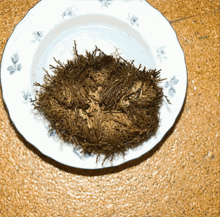This is an old revision of this page, as edited by 2a02:908:13c9:b600:3c86:e480:8308:7507 (talk) at 19:46, 28 October 2022 (Correction). The present address (URL) is a permanent link to this revision, which may differ significantly from the current revision.
Revision as of 19:46, 28 October 2022 by 2a02:908:13c9:b600:3c86:e480:8308:7507 (talk) (Correction)(diff) ← Previous revision | Latest revision (diff) | Newer revision → (diff)A resurrection plant is any poikilohydric plant that can survive extreme dehydration, even over months or years.

Examples include:
- Anastatica hierochuntica, also known as the Rose of Jericho, a plant species native to deserts of North Africa. It's not a resurrection plant, because it only expands when rehydrated but not revive. and it's often confused with Salaginella lepidophylla.
- Asteriscus (plant);
- Boea hygrometrica,
- Craterostigma, members of the Linderniaceae/Scrophulariaceae with snapdragon-like flowers
- Haberlea rhodopensis
- Lichen, a symbiosis that can survive in extreme desiccation,
- Mesembryanthemum, the plant can revive within a short period of time after a drought
- Myrothamnus flabellifolius, a plant species native to Southern Africa
- Pleopeltis polypodioides, also known as resurrection fern
- Ramonda serbica, a species in the family Gesneriaceae
- Selaginella lepidophylla, a plant species native to North America, Central and South America, and sold as a novelty
- Tillandsia
- Xerophyta, a monocotyledonous genus typically occurring on rock outcrops in Southern African grasslands
Certain resurrection plants have long been sold in their dry, "lifeless" form as curiosities. This custom was noted by many 19th century authors, and continues today.
In December, 2015, resurrection plants were featured in a TED talk given by Professor Jill Farrant , Molecular and Cell Biology, University of Cape Town, South Africa, who performs targeted genetic modification of crop plants to make them tolerate desiccation by activating genes that are already there but not natively expressed in response to drought.
See also
References
- Liberty Hyde Bailey (1916). The Standard Cyclopedia of Horticulture. Vol. 5. The Macmillan company. pp. 2920–2921, 3639.
- Zhang, T.; Fang, Y.; Wang, X.; Deng, X.; Zhang, X.; Hu, S.; Yu, J. (2012). Badger, Jonathan H (ed.). "The Complete Chloroplast and Mitochondrial Genome Sequences of Boea hygrometrica: Insights into the Evolution of Plant Organellar Genomes". PLOS ONE. 7 (1): e30531. Bibcode:2012PLoSO...730531Z. doi:10.1371/journal.pone.0030531. PMC 3264610. PMID 22291979.
- "Resurrection Plant". Faculty.ucc.edu. Retrieved 2012-01-30.
- "TED Speaker: Jill Farrant". TED.com. Retrieved 2016-01-21.
- "TED Talk: How we can make crops survive without water". TED.com. Retrieved 2016-01-21.
If an internal link led you here, you may wish to edit the linking article so that it links directly to the intended article.
This botany article is a stub. You can help Misplaced Pages by expanding it. |